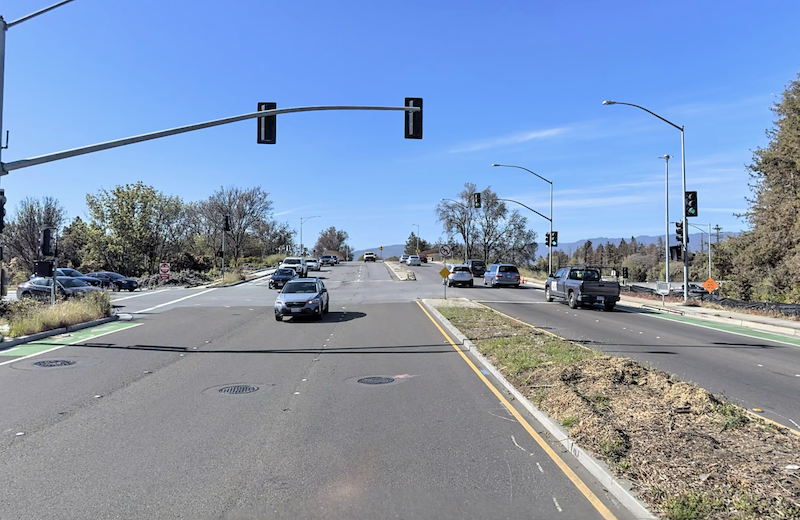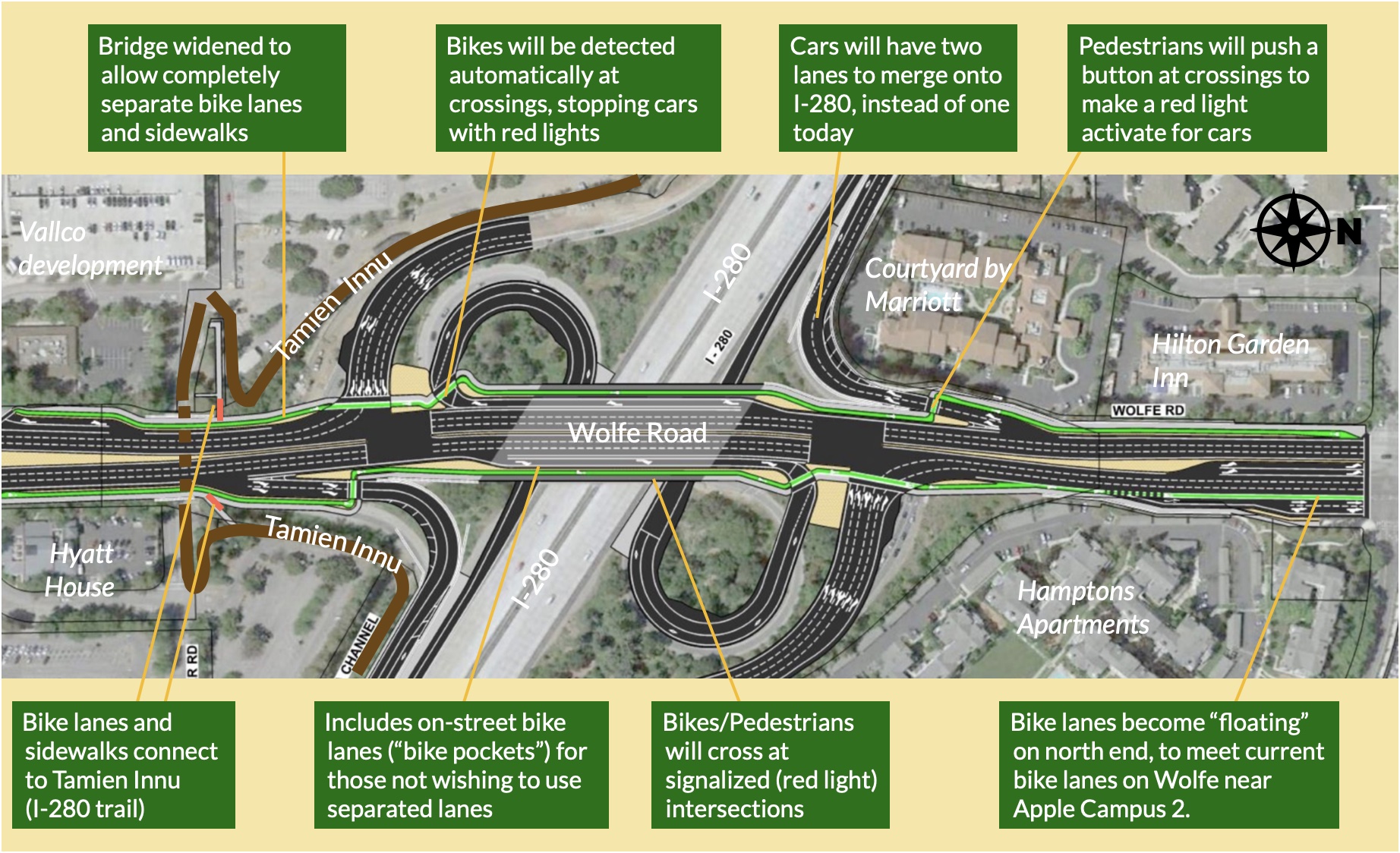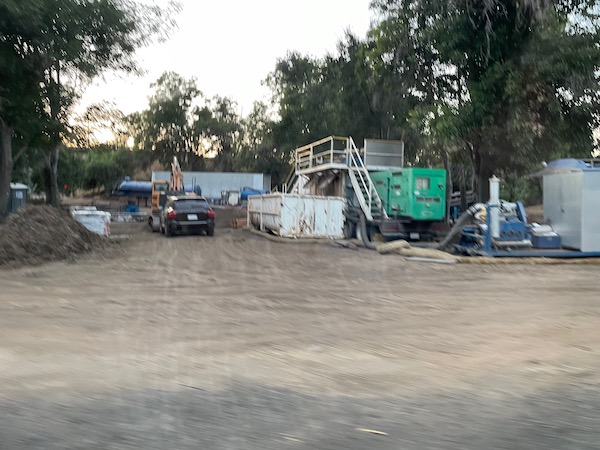The construction of the new bridge at Wolfe Road over I-280 has now begun. Completion is expected in 2025. The new bridge will be an improvement for both pedestrians and cyclists which face dangerous conditions today when using that stretch of road.
The new bridge is expected to be built without closing Wolfe Road to through traffic at any time. The off- and on-ramps are being completely reconstructed into new shapes, so are expected to have temporary closures and re-routing of traffic to a single off- or on-ramp during the project work.
The timing and financing for this project has an update since the article was posted. Please click here to go to the update from David Stillman, Cupertino Transportation Manager.

Wolfe Road today facing south toward the overpass.
Big Improvements for Cyclists and Pedestrians
The project features some definite improvements over today’s configuration. These include:
- Off-street separated bike lanes and sidewalks, divided by a landscaping barrier.
- An on-street painted bike lane that runs alongside vehicle traffic for cyclists not wishing to use the off-street bike path.
- Perpendicular crossings for cyclists and pedestrians at on- and off-ramps with red lights to stop car traffic.
- Bike sensors on the bike path to detect cyclists and trigger a red light for cars so bikes can cross safely (pedestrians will push a button).
- Two lanes for cars entering I-280, instead of two lanes merging into one and then entering.
- Direct connections to the east/west Tamien Innu (I-280 trail).
- Third through-lane added to Wolfe Road, and dedicated right-turn lanes for on-ramp loops.
- Metering lights added to each on-ramp to the highway to reduce highway congestion.
“We know that our transportation landscape is changing quickly, and there’s a lot of different users on the roadway these days, so we’re trying to have the foresight to build a facility that accommodates all ages and abilities,” says John Cacciotti, Project Manager for HMH Engineers, the firm who designed the project. “We expect a high volume of pedestrians and bicyclists through this area.”
Open Questions and Concerns
During the review a few years ago (see this WBC article from 2020), there were still a few open questions, such as whether there would be a southbound connection to the Tamien Innu, and how the signalized crossings at the off-and on-ramps would be handled for bike and pedestrian traffic. Those have been resolved now per Cupertino Transportation Manager David Stillman. “At the ramps, there will be push button detection as well as stop bar and advance bike loops. In theory the advance bike loops should detect approaching bikes in time for the light to cycle red for approaching cars before the bikes reach the ramp. Pedestrians will need to push the button to be detected.”
There are a few issues that still are a concern to the biking community, however. One of these is the “floating” bike lane that connect to a similar lane on the north side of the bridge. The lane is crossed by two streams of traffic that are going into two lanes turning right into the Apple campus. Sandwiching cyclists between lanes of cars is quite dangerous, especially when the cars must cross the lane.
Key Facts about this Project
Cost
The estimate is $80 – $90 million, funded by VTA 2016 Measure B funding.
Timing
Construction is expected to be complete by 2025.
Overall Project Plans:
- replace existing bridge with wider bridge
- create new wider on- and off-ramps
- Add off-street bike lanes and sidewalks
- Add new lighting and landscape; replant trees/greenery lost during construction
- Add retaining and sound walls as needed.
New bridge lifespan
75 years
Construction equipment is being stored in the spaces inside each on-ramp loop. These will be replanted with trees and landscape once the bridge is completed.
A second issue is that to traverse the bridge, cyclists and pedestrians must make three crossings of car lanes. Many new bridges are being built today with ‘flying’ pedestrian and bike overpasses that do not require cyclists or pedestrians to cross traffic to use the bridge. This is the safest method.
A further concern of the surrounding community is whether the new bridge fully considers the load that the new Vallco/The Rise project will add on traffic. John Cacciotti from HMH is clear on this point. “We’ve take a conservative approach to what we anticipate demand will be through this interchange and have included the Vallco Development in our projections.”
As Lam Trinh, VTA Project Manager, noted in 2020, “The current bike lanes and sidewalk [on the Wolfe overpass] are very narrow, and have to cross the high speed off ramp which really discourages use by bicyclists and pedestrians.” We are looking forward to the new bridge and the possibilities for safer cycling and walking over this bridge in Cupertino. We’ll keep you updated on the progress as it happens.
Update (November 17, 2023) from David Stillman, City of Cupertino Transportation Manager:
The construction work on Wolfe Road at I-280 that is currently wrapping up is sanitary sewer relocation work that is necessary to complete prior to proceeding with the interchange replacement project itself. The current project cost estimate for the interchange is $120 million and it is scheduled for construction in FY 2025. There is a $20 million gap in construction funding, of which $10 million is anticipated to be covered by additional Measure B funding per VTA Board 2016 Measure B Highway Program. The remainder must come from non-Measure B sources. VTA staff has proposed $6 million to be funded through the State Transportation Improvement Program (STIP), ultimately resulting in a current $4 million funding gap.
The information in this article is solely the opinion of the author and Walk-Bike Cupertino and does not reflect the opinions of any other organization or entity. For more information, contact WBC at info@walkbikecupertino.org.



This is surely an improvement over the current conditions.
But why in the year 2023 are bikes and peds still being given the scraps? Cars get 3 straight-through lanes with 2 traffic signals. Bikes and peds get a path with 90-degree zigzags and 4 traffic signals.
At the very least, it should be cars that have to make a 90-degree turn onto the freeway on-ramps, so that bikes and peds can travel in a straight line. For an example, look at the intersection of 85 and El Camino Real in Mountain View: the on-ramp from ECR south to 85 south has a sharp turn, making it much safer and more efficient for bikes and peds.
I’m disappointed in this new/proposed Wolfe Rd bridge. It is the usual car-centric kludge to add the facade of safety for cyclists and pedestrians. Why are there still so many grade crossings for the bikes through the paths of vehicles that require us to trust those vehicles to provide the safety we need? Besides being points of danger for the bikes, these are points of additional delay for cars, especially as bike traffic increases.
This should be reworked to provide grade separation between the bikes/pedestrians and the cars. One option is to use the clover leafs as a chance to transition the bikes down to a lower level where they can then pass under the on/off ramps. We might also consider putting both directions of travel on a shared route for crossing I-280 to reduce the cost of such tunnels (half as many). Perhaps using the center/median as the bike/ped lane those users would be away from the merging since they have no need for the on/off ramps. This could be made efficient by extending it to beyond just this overpass to address problems facing bikes to the north and south as well.
Due to a slight curve and frequent traffic blockage, car accidents often occur on S/B 280 approaching the off ramp. Also, the curved merger of on-ramp lanes getting onto S/B 280 is always a hazard. As usual, it appears VTA is spending $90 million to update an intersection without addressing some of the problems.